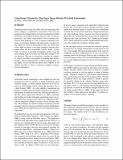| dc.contributor.author | Yang, Di | |
| dc.contributor.author | Malcolm, Alison E. | |
| dc.contributor.author | Fehler, Michael | |
| dc.contributor.other | Massachusetts Institute of Technology. Earth Resources Laboratory | |
| dc.date.accessioned | 2014-10-02T14:56:51Z | |
| dc.date.available | 2014-10-02T14:56:51Z | |
| dc.date.issued | 2013 | |
| dc.identifier.uri | http://hdl.handle.net/1721.1/90530 | |
| dc.description.abstract | Time-lapse seismic data are widely used for monitoring subsurface changes. A quantitative assessment of how reservoir properties have changed allows for better interpretation of fluid substitution and migration during processes like oil and gas production, and carbon sequestration. Full waveform inversion has been proposed as a way to retrieve quantitative estimates of subsurface properties through seismic waveform fitting. However, for most monitoring systems, the offset range versus depth of interest is not large enough to provide information about the low wavenumber velocity model. In this study, we present a wavefield tomography method using the local warping between baseline and time-lapse images as the cost function. The new cost function is sensitive to volumetric velocity anomalies, and capable of handling large velocity changes, where traditional full waveform inversion fails. In this paper, we first describe the theory and workflow of our method, and then we show a numerical example to demonstrate its advantages. | en_US |
| dc.description.sponsorship | Massachusetts Institute of Technology. Earth Resources Laboratory (Founding Members Consortium) | en_US |
| dc.publisher | Massachusetts Institute of Technology. Earth Resources Laboratory | en_US |
| dc.relation.ispartofseries | Earth Resources Laboratory Industry Consortia Annual Report;2013-36 | |
| dc.title | Using Image Warping for Time-lapse Image Domain Wavefield Tomography | en_US |
| dc.type | Technical Report | en_US |
